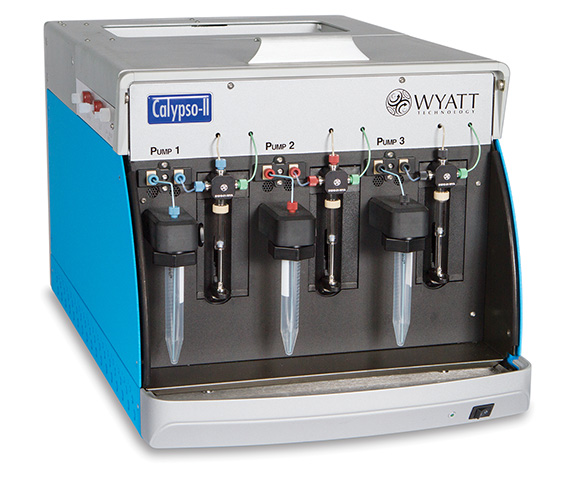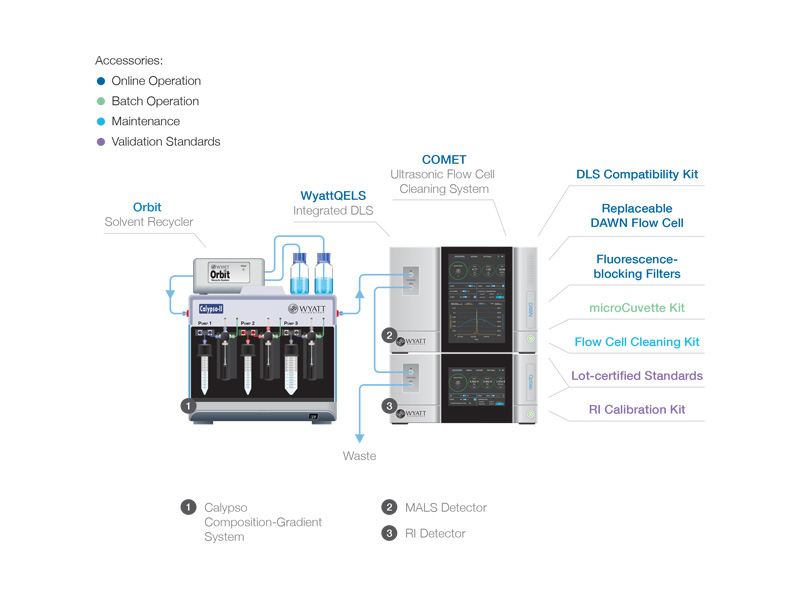CG-MALS
CG-MALS 的无标签化,无固定化的特征是此技术的第一准则,它通过监测由复合物的形成或解离引起的溶液摩尔质量的变化,直接测量相互作用。 应用CG-MALS表征:
- 自缔合和异缔合
- 从 pM 到 mM 的结合亲和力
- 绝对分子化学计量(不仅仅是相对摩尔质量)
- 多价或合作互动; 同时自我和异性联系
- 在数秒至数小时的时间范围内测量结合,聚集或解离的动力学
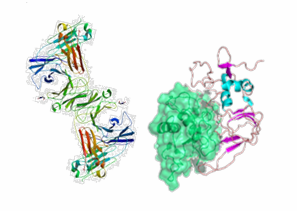
CG-MALS可表征自缔合和异缔合。
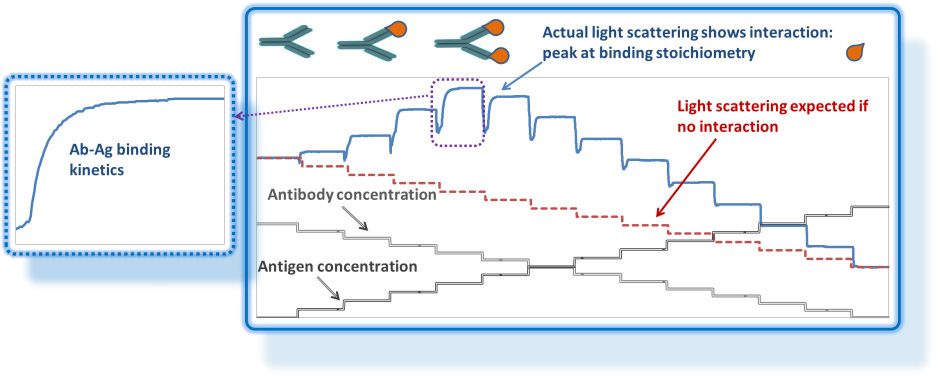
CG-MALS的工作原理是将不同组分的样品和稀释液混合,然后测量每个组分溶液的重均摩尔质量。此外,结合动力学通常也能同时观察到并进行量化。
CG-MALS 还可以表征高浓度蛋白质之间以及蛋白质与赋形剂之间的非特异性相互作用,从而影响配制的生物治疗药剂的胶体稳定性。 请与 Wyatt 联系,以了解 CG-MALS 如何解决您的特定生物分子相互作用分析,例如:
- 单克隆抗体或双特异性融合蛋白的药物靶标结合
- 单价或多价受体
- 在各种缓冲条件下的自关联
- 结构生物学中的多蛋白组装
- 蛋白质浓度为100 mg / mL或更高时的胶体稳定性
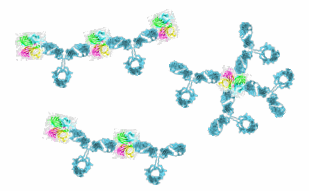
CG-MALS擅长分析多蛋白复合体。
部分文献
Attri, A. K.; Fernández, C.; Minton, A. P. Self-association of Zn-insulin at neutral pH: investigation by concentration gradient static and dynamic light scattering. Biophys. Chem. 2010, 148, 23-27.
Esfandiary, R.; Hayes, D. B.; Parupudi, A.; Casas-Finet, J.; Bai, S.; Samra, H. S.; Shah, A. U.; Sathish, H. A. A systematic multitechnique approach for detection and characterization of reversible self-association during formulation development of therapeutic antibodies. J. Pharm. Sci. 2013, 102, 3089-3099.
Monterroso, B.; Alfonso, C.; Zorilla, S.; Rivas, G. Combined analytical ultracentrifugation, light scattering and fluorescence spectroscopy studies on the functional associations of the bacterial division FtsZ protein. Methods 2013, 59, 349-362.
Smith, M. H.; Lyon, L. A. Tunable encapsulation of proteins within charged microgels. Macromolecules 2011, 44, 8154-8160.
Some, D. Light scattering based analysis of biomolecular interactions. Biophys. Rev. 2013, 5, 147-158.
与 CG-MALS 检测相关的仪器
MALS 检测器
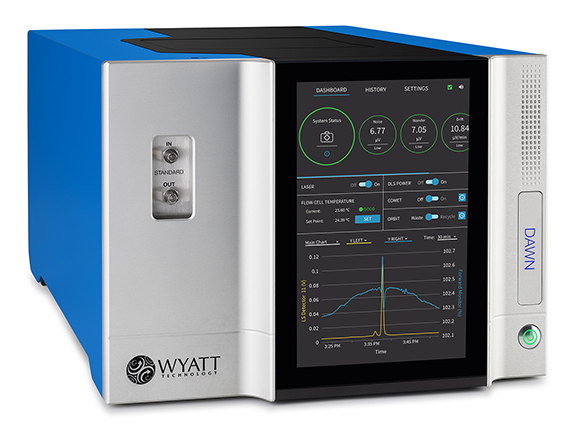
DAWN® - 最灵敏的MALS探测器。配备18个角度的探测器,用以确定 200 Da ~ 1 GDa 摩尔质量和10 ~ 500 nm半径的分子。
- 标准选项:常温型
- 制冷/加热型:-15 ~ 150 ℃
- 超高温型:20 ℃ ~ 210 ℃
DAWN提供了处理荧光样品的特殊信号:荧光屏蔽滤光片和785nm的红外激光。
miniDAWN® - 3角度光散射探测器,用以测定200 Da ~ 10 MDa摩尔质量和10–50 nm半径的分子(仅限环境温度)。
DynaPro® NanoStar® - NanoStar 使用的样品体积小至1.25 µL,温度控制范围在 -15 °C ~ + 150 °C之间,超越了传统的基于比色皿的DLS仪器,同时它提供了优化的静态光散射检测器(与DLS检测平行) 系统),可以与 CALYPSO 软件一起使用,以很少的样品进行 CG-MALS 实验。 样品必须手动制备,而不能利用Calypso的自动化功能。
动态光散射检测器
CALYPSO™ 软件不会分析DLS数据,但可以设置为通过 Wyatt 的 ASTRA® 软件触发 DLS 数据获取。
WyattQELS™ - 一种动态光散射(DLS)模块,它集成在 DAWN 或 miniDAWN MALS探测器中,在相同的散射体积下提供同时的DLS测量。
DynaPro® NanoStar® II - NanoStar 使用的样品体积小至2 µL,温度控制范围在 -10 °C ~ + 120 °C之间,超越了传统的基于比色皿的DLS仪器,同时它提供了优化的静态光散射检测器(与DLS检测平行) 系统),可以与 CALYPSO 软件一起使用,以很少的样品进行 CG-MALS 实验。 样品必须手动制备,而不能利用Calypso的自动化功能。
示差折光检测器
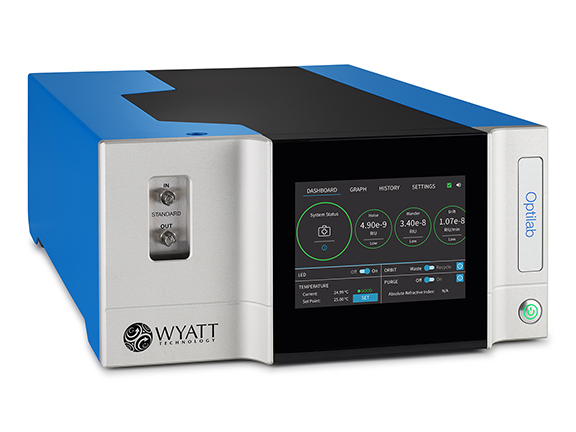
Optilab® - 一种独特的在线示差折光检测器,用于测量任何大分子的浓度,且不受发光基团的影响。温度可以在4°C ~ 65°C之间调节。同时,它可以测量高达180 mg/mL蛋白质溶液的浓度。
Software
CALYPSO™ - CALYPSO 软件可对生物分子相互作用进行 CG-MALS 分析,控制样品的制备和输送,数据采集和数据分析。 提供最广泛的关联模型套件,可用于确定大分子相互作用的亲和力和绝对分子化学计量,包括蛋白质-蛋白质结合,受体与肽或蛋白质的结合等,以及反应动力学的一级分析。
如果您对其他技术或将其它技术与 CG-MALS 联用感兴趣,请看:
SEC-MALS: Wyatt MALS 检测器是所有蛋白质,生物聚合物和合成聚合物表征实验室的标准配置,可提供可靠,强大的测量价值。
FFF-MALS: 将FFF系统耦合到 Wyatt MALS 或 DLS 检测器可创建一个功能强大的系统,可对简单或复杂样品的摩尔质量和大小分布进行准确,可靠的表征。
DLS: 通过量化散射光中的动态波动来测量溶液中纳米粒子和胶体的平移扩散系数Dt。 DLS 适用于 0.2 nm ~ 5,000 nm Rh 的测量。
MP-PALS: Wyatt Technology 的突破性大规模平行相分析光散射(MP-PALS)将强大的 ELS 测量扩展到了天然缓冲溶液中的蛋白质和其他生物分子。 MP-PALS可以做传统zeta电位仪可以做的所有事情,甚至更多。
SEC-IV: SEC-IV 可能是表征某些不适合使用 SEC-MALS 分析的材料的最佳方法。通过简单地添加 DAWN,将基本的 SEC-IV 设置转换为功能强大的 SEC-MALS-IV 聚合物表征站,即可分析摩尔质量和尺寸的绝对测定,而无需考虑构象,支链聚合物,共聚物并从头测量Mark-Houwink系数。

